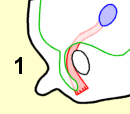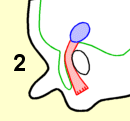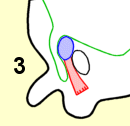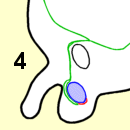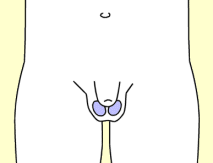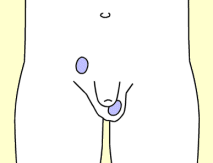|
男性性生理問題 |
|
隱睾症
醫學術語:隱睾症(Cryptorchidism
)(自希臘語“kryptos:隱藏的”+“orchis:睾丸”)
|
|
|
|
|
|
|
|
|
|
當男胎在子宮內發育的時候,他的睾丸會逐漸降入發育中的陰囊。此處所示為在導向組織索的協助下正在降入陰囊的睾丸(蘭色):
1.第二月;
2.第三月;
3.第七曰;
4.出生時。
As the fetus grows inside the womb, his testicles gradually descend into the developing scrotal sac. Shown here is a testicle (blue) descending with the help of a guiding cord (red) into the scrotum.
1 second month
2 third month
3 seventh month
4 at birth
|
|
|
|
|
|
當男胎在子宮內發育時,他的睾丸在其腹腔內生成,然後在臨出生前不久,下降到陰囊。可是,在某些病例,睾丸未能下降,男嬰仍帶著未下降的睾丸出生了。新生男嬰中,隱睾症的發生率約為4%,而早產兒中約有30%。只有一個睾丸未能下降也是可能的。在某些罕見的病例,已經下降到陰囊的睾丸又往上移到腹股溝區[所謂回撤睾丸(retractile testicle)]。通常,醫生能夠簡單地從這個區域把睾丸重定。
在大多數的情況下,未下降的睾丸在出生後數月內會自動向下移入陰囊。可是,如果沒有發生這種自動的重定,就需要去治療了,因為,在腹膜腔內,睾丸暴露在常規的體溫之下,這個體溫對於正常產生精子溫度過高。這將導致男性不育。隱睾症也有引起疝氣的危險,甚或演變成睾丸腫瘤。
|
|
|
|
男嬰:(左)雙側睾丸已經降入陰囊;(右)一側睾丸沒有下降而仍存留在腹膜腔。
Infant boys: (left) Both testicles have descended into the scrotum.
(right) One testicle has not descended but has remained inside the abdomen.
|
治
療
隱睾症的常規治療是外科手術。復位手術應該盡可能早地實施,也就是說,在出生後第3-18個月內進行。這將為避免往後的不育症提供了最好的時機。出身時帶有隱睾症或因該症經過治療的男孩當進入青春期時,應該被告知疾病真相,並且應該學會如何有規律地自我檢查睾丸,以探測任何腫塊以及由此所致的可能的早期睾丸癌的跡象。這種自我檢查實際上被推薦給所有的男子(見睾丸自查)。至於成年男子,睾丸外科手術復位並由此而想恢復生育能力通常是太遲了。代替復位手術的,可能單純地切除睾丸。通常,對超過40歲的隱睾症男性患者根本不再進行任何治療了。
|
|
Physical Problems in Males Undescended Testicles
Medical term:
Cryptorchidism (gr. kryptos: “hidden” + orchis: “testicle”)
As a male fetus grows inside his mother's womb, his testicles form inside his abdomen and then, shortly before birth, descend into the scrotum. However, in some cases, this fails to happen and the infant boy is born with still
undescended testicles. The condition is found in about 4% of newborn boys and in about 30% of boys born prematurely. It is also possible that only one of the two testicles fails to descend. In some rare cases, a testicle that has already descended into the scrotum moves up again into the groin area (a so-called
retractile testicle). Usually, the doctor can simply retract it from there.
In
most cases, undescended testicles move
down into the scrotal sac on their own
within the first few months.
However, if this does not happen,
treatment becomes necessary, because
inside the abdomen the testicles are
exposed to normal body temperature which
is too high for normal sperm production.
This could lead to infertility. There is
also some danger of a hernia or even a
tumor developing.
|
|
Treatment
The usual treatment of undescended testicles is surgery. It should be performed as soon as possible, i.e. between the 3rd and 18th month after birth. This offers the best chance of avoiding later infertility. Males born with and treated for undescended testicles should be told about it when they reach puberty, and they should learn how to do a regular self-exam of their testicles in order to detect any lumps and thus possible early signs of testicluar cancer. Such self-exams are actually recommened for all males (see
Testicular self-examination). For adult males, it is usually too late to move undescended testicles into the scrotum and thus to restore fertility. Instead, the testicles may simply be surgically removed. As a rule, men over 40 no longer receive any treatment for this condition at all.
|


